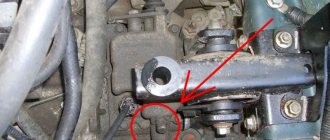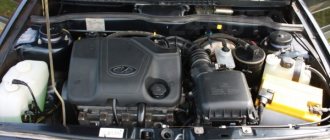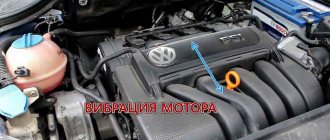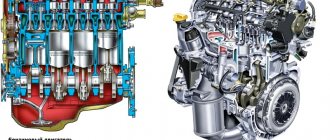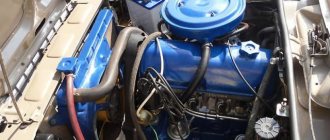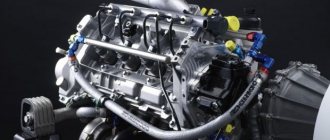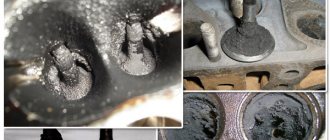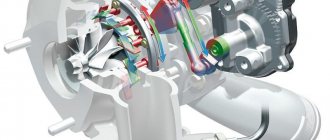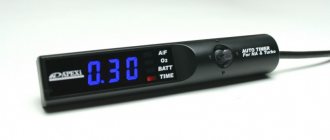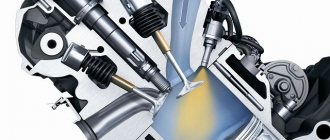Many car owners are interested in the reasons why a diesel engine stalls and how to deal with it. This malfunction occurs when one of the cylinders fails. The very concept of “troit” has been known since the times when cars were equipped with exclusively four-cylinder engines. If one of them fails, the function of the entire unit is disrupted, hence the name of the term, which has remained unchanged to this day. The movement of the motor is accompanied by increased vibration, which occurs due to the movement of the elements of the non-working cylinder without pressure and corresponding load.
The second way to identify the malfunction in question is to check the diesel engine by touch. After running the engine, you need to let it cool thoroughly, then start it again. A header pipe that is cold or lukewarm indicates a broken cylinder.
Main reasons
The reasons why a diesel engine stalls can be listed in this order:
- Low compression in cylinders. In this case, the temperature inside the cylinder does not reach the level necessary to ignite the fuel. This may occur due to a faulty injector or malfunction of the high pressure fuel pump;
- Lack of fuel in the combustion chamber. Again, the reason may lie in the injection pump, namely, the failure of the plunger pair.
- The car can be started from a tow or when hot, but will not start after the engine cools down;
- Spark plug
. Their malfunction of these elements is one of the most common factors causing the power unit to trip. Timely checking of spark plugs and their regular replacement will avoid such troubles; - Inconsistency in the thickness of the gasket in the cylinder head;
- Valve mechanism malfunction;
- Bad fuel and worn filters;
- Incorrectly set diesel fuel injection timing.
- To clarify the specific reason that the engine is running rough, you need to contact a service center.
Heavy exhaust smoke
The appearance of black smoke from the exhaust pipe indicates an overload of the power unit. Changing to a lower gear will clear the exhaust. This phenomenon may also be caused by a lack of air due to a dirty air filter. Flushing a car's air cleaner cleans up the exhaust.
White smoke may appear when the engine is not warmed up or after water gets into the diesel fuel. Blue smoke can serve as a signal to the driver that the oil level in the pan is too high. Bringing it to normal eliminates the appearance of smoke. Signs of piston wear are also determined by the appearance of blue smoke. You should also check the reliability of the connections in the pipelines and do not forget to drain the sediment from the fuel tank.
How to determine the malfunction yourself?
To identify the reason why the motor is tripping on its own, you must adhere to certain rules. First of all, you should evaluate the sound of the engine and its functions while driving. If any changes and vibration noises are noticeable, this may well be a sign that the power unit is malfunctioning.
On a warm car, characteristic sounds indicate the malfunction in question. At idle, uneven engine operation with twitching is also a sign of a malfunction of one of the cylinders. Particular attention should be paid to spark plugs and high-voltage wires. If you have any doubts that the motor is malfunctioning, it is better to contact a specialist, since delaying diagnostics and repairs can lead to serious damage.
What to do?
If you have the appropriate experience and have decided to independently eliminate the cause of the engine tripping, you first need to identify the source of the problem. Often the culprit of the malfunction in question is a defect or malfunction in the operation of the injectors. A critically worn nozzle, low pressure inside the injection elements, dirty channels, poor quality fuel - these are the main factors affecting the functionality of the injectors (see the article “How to check an injector nozzle”).
To fix the problem, you can clean the sprayer or replace it. It is recommended to update injectors on diesel power units every 120-150 thousand kilometers. A defective injector can be identified experimentally by moving it to another cylinder. If it also acts up, a malfunction has been detected.
If there is a cause of tripping caused by a faulty fuel injection pump, it may require repair or complete replacement. You can check this in practice using the same method as with the nozzle. If, after replacing the latter with a new part, the cylinder shows no signs of life, then the cause of the malfunction most likely lies in the high-pressure fuel pump.
A diesel engine may malfunction due to a malfunction of the valve mechanism of the problem cylinder. Typically this problem is accompanied by valve knocking. First of all, it is necessary to check the gaps between the elements and, if necessary, adjust them. Violation of the distances between the valves contributes to the fact that the diesel engine only stalls when the engine is hot. With such a malfunction, sufficient compression will not be created in the engine.
Spark plugs with soot affect the appearance of the problem in question, most often in cold weather when the engine is not warmed up. They should be replaced in a timely manner. The faults discussed are the main reasons why a diesel engine stalls. For timely treatment of the “heart” of the car, it is necessary to take immediate action by contacting a service station or on your own, if you have experience and confidence in a positive result.
When a diesel engine fails, the reasons should be looked for in several places, and this is what our review will be about. In general, we should mention what troit is. This means that one of the engine cylinders has stopped working, that is, fuel does not flow to it, and the “heart” of the car operates unevenly, it shakes convulsively. After a short preamble, we will begin to find out the reasons.
Troubleshooting
- If the spark plug is faulty, you can either clean off the carbon deposits that have formed, or replace the non-functioning spark plug with a new one. Both options are good in their own way, depending on the availability of money or free time. To prevent the formation of new carbon deposits, you should periodically check the serviceability of the injectors and valves, prevent overheating of the engine and perform other simple manipulations.
- Damage to high voltage wires.
The best solution is to replace the damaged wires, however, if when checking the winding resistance it is greater than or equal to 20 kOhm), you can cover the damaged area with electrical tape or clean the oxidized parts.
Injector malfunction. If this is an injection engine, then the existing injector may become unusable for a huge number of reasons, such as an open or shorted power circuit, low-quality fuel for use, or breakdown of both the injector itself and its parts.
Confidence in your abilities and the presence of the necessary skills allow you to fix the problem yourself or seek help from service station professionals.
- Low pressure.
This is explained by a leak in the exhaust valve or damage to the gasket on the cylinder head.
- Distributor cap faulty.
The only way to solve this problem is to replace the damaged cover with a new one.
- Poor quality fuel.
If problems arise with a decrease in fuel quality, it makes sense to resort to high-class fuel (diesel oil).
We recommend: Clutch repair. Repair of discs and master cylinder
How to determine if the engine is stalling?
If you decide to determine on your own whether the engine is shaking during operation, then you should adhere to certain initial data. First, you need to remember what the sound of the engine was before during the trip, try to find differences in the operation of the engine itself, see if the speed “floats”, when accelerating the car, try to determine whether it has lost power or not. This, of course, can only be done by an experienced motorist, and it is important that he drives the suspect vehicle for a significant amount of time.
This malfunction can also be determined with a warm car. You have to stand near the exhaust pipe and listen for uniformly distinct “boo-boo-boo” sounds, which mean that the engine is throttling. This must be done only when the car is warm, since the characteristic sound can also be produced by simply frozen working parts of the car.
When the car is running, you need to feel how the car will idle. If its operation is uneven, it jerks periodically, then this may mean that you have a problem with one of the cylinders. If you still doubt whether the engine is running or not, then you need to contact an experienced specialist or a service station. You need to know that this breakdown is very serious and requires urgent repairs.
Why does a diesel engine stall - the main reasons
There are not so many reasons for diesel engine throttling. One of them is low compression (pressure), in which the required temperature for ignition of the fuel is not reached inside the cylinder. The culprit may also be a non-working injector, which should spray fuel along the cylinder walls. And the last explanation for this malfunction may be a breakdown of the injection pump (high pressure fuel pump), for example, a plunger pair has failed.
If you operate the engine on three cylinders instead of four, this can lead to very serious damage. Due to the small number of cylinders remaining in service, problems will make themselves known faster. They arise due to very rapid wear of the main parts in the engine, as well as their excessive overheating. But despite this, you can still get to the nearest car service center, of course, if it is not 1000 kilometers away from you.
Having noticed a problem on a warm engine, you should also check whether the diesel engine is running cold or not. Any dimensional defect, even an error in the thickness of the block gasket, leads to a slight deviation in the operation of the motor, and this is visible only when it is cold. After warming up, compression (which suffers due to imperfect contact of parts) already returns to normal, the beating disappears. A cold engine may stall due to poor performance of the spark plugs; after warming up, this defect also disappears, but since it nevertheless manifested itself, it makes sense to check the condition of the spark plugs.
About possible overheating
First of all, check the coolant level in the radiator and if it is insufficient, add the required amount of antifreeze. Problems can arise through a thermostat failure. If it gets stuck in the closed position, the coolant, moving in a small circle, will quickly overheat. In this case, only replacing it will correct the situation. Clogged cooling system, especially the radiator, and weak fan belt tension also lead to overheating of the power unit.
Knocking noises during operation
. This can happen due to increased clearance in the valve timing mechanism; in this case, valve adjustment is necessary. Ignition too early leads to knocking noise in the fuel pump. It is necessary to correctly set the timing of the supply of high pressure fuel into the combustion chamber of the cylinder. A faulty injector can also be a source of knocking noise in diesel engines.
- “Checking diesel engine injectors”;
- “Do-it-yourself repair of Common Rail, Delphi, Denso injectors”;
- “How to determine early or late ignition and which is better.”
What can you do to help the engine if it is misfiring?
Every car owner would like to help his car himself, because this is his faithful “iron horse”. However, this machine system is quite sensitive to errors, so weigh the pros and cons, especially if you have little experience. It is worth noting that if you do not understand the car well, or you are simply not sure that the engine is actually running, then you should definitely stop by a technical inspection station or a service center. First of all, you need to diagnose the engine, find out whether the problem is in the engine or not.
If the problem is still there, then it is worth determining which cylinder was not working (by heating the inlet to the manifold).
The next step is to find out why this cylinder failed. The main culprits are faulty injectors. Often the atomizer located inside them wears out and fails. Another reason for a non-functioning injector may be low pressure that is created inside it, or the channels are simply clogged with various types of contaminants due to low-quality fuel. The nozzle can be changed by selecting it according to the nozzle model. But sometimes this is not possible, for example, the model is rare or stores do not currently have this part in stock.
In such cases, there are alternatives to fix a non-working atomizer; you can try cleaning it, for example, with ultrasound. The result may be far from perfect, but the mechanism will still start working. In diesel cars, this method can lead to damage to parts and accelerate their wear, so ultrasonic cleaning is used less and less for them. If it is not possible to completely remove carbon deposits and dirt, you can try soaking the part in a solvent and then treating it with ultrasonics again. When you don’t want to do the cleaning, but no sprayers that match your model are on sale, you can try to buy one that is very similar in size and start grinding it in.
Reasons for tripping of diesel internal combustion engines
It is somewhat easier to answer the question of why a diesel engine is tripping, to determine the causes and to localize the fault compared to gasoline units.
A diesel engine often “troubles” for two main reasons: lack of proper compression of the mixture or problems with fuel supply. It is more difficult to determine the cause if all cylinders are working, but the diesel engine still vibrates and operates erratically. The cause may also be air leaks, problems with sensors, ECU, etc. It is often difficult to quickly find such a malfunction.
The main difference in the operation of a diesel engine is the method of ignition of the fuel-air mixture. Diesel fuel is ignited in the cylinder due to compression. In other words, diesel fuel spontaneously ignites. Additionally, it is necessary to take into account the moment when the “triple motion” of a diesel engine increases. A diesel engine can bleed cold, hot, idling and/or under load. The problem may appear only in a specific narrow speed range, occur periodically, or be present constantly.
Diesel fuel does not ignite: compression is lost
The cylinder-piston group of any internal combustion engine experiences increased loads. During operation, the gaps between the parts of the CPG increase as the elements wear out. The valves of the gas distribution mechanism are also subject to wear.
The loss of the ability to ensure tightness when one of these parts is destroyed leads to the fact that proper heating of the mixture is not ensured during the compression stroke. Diesel fuel simply cannot ignite.
If the compression ratio is insufficient (loss of compression), the diesel engine throttles strongly after a cold start. As a result of heating, the CPG parts expand and the seal in the cylinder increases. A heated diesel engine shakes noticeably less, and the tripping effect may disappear completely. This phenomenon is observed only if there is no critical wear of the CPG or valve mechanism elements.
It turns out that the wear of the cylinder-piston group with engine heating is partially compensated due to the fact that the diesel fuel in the cylinders self-ignites due to an increase in the temperature of the internal combustion engine. There is a situation where a diesel engine misfires after replacing the cylinder head gasket with a new one. In this case, the working unit with a worn-out CPG throttles strongly “on cold” and adjusts “on hot”.
This malfunction is explained by the fact that the new gasket is thicker than the old one. The result is a lower compression ratio, further exacerbating existing compression problems. A thicker gasket affects the efficiency of self-ignition of the working mixture of diesel fuel and air in such an engine.
Diesel misfires due to glow plugs
Glow plugs play an important role in a diesel engine. For a confident start “on cold”, the glow plugs heat the combustion chamber. This is necessary so that self-ignition of the mixture of air and diesel fuel occurs easily during startup. Next, the glow plug continues to maintain the set temperature in the cylinder until the engine finally reaches operating temperature. After this, the candles automatically turn off.
After contact with the candles, diesel fuel scatters into tiny particles, partially evaporates, and mixes better with the air. As a result, the resulting mixture burns as efficiently as possible, transferring energy to the piston. If the glow plug is faulty, the temperature in the cylinder during a cold start will be too low and the diesel fuel will not be able to self-ignite.
The cylinder will be inoperative, although it will receive fuel, which then enters the exhaust system of the diesel engine. In this case, the diesel engine often produces dark gray or black exhaust. As the temperature of the internal combustion engine increases, the fuel (taking into account normal compression) will begin to ignite, but intermittently. The problem will go away completely after warming up, but with a subsequent cold start the malfunction will recur.
Diesel shakes and smokes: problems with fuel supply
If there are problems with the fuel supply, then the diesel engine starts to stall for the following reasons:
- the fuel pump does not create optimal pressure in the fuel supply system;
- the injection intensity is disrupted as a result of a malfunction of the diesel injector;
In both cases, fuel atomization deteriorates and the mixture does not burn completely. The fuel injection pump can create normal pressure, but the fuel injectors deliver different amounts of fuel to the cylinders. In such conditions, fuel is distributed unevenly among the cylinders, the engine shakes in different operating modes. If it is completely impossible to pump a portion of diesel fuel through the nozzle, the diesel engine begins to stall. Cleaning, repairing, or replacing injectors must be accompanied by adjustment of the injectors before installation on the engine.
At the same time, it is necessary to regulate the fuel injection pump. The pump may be worn out and/or incorrectly adjusted, resulting in insufficient pressure to deliver the required amount of diesel fuel through the rebuilt or replaced injectors. The diesel engine may start to run rough, with detonation. Replacing injectors is necessarily accompanied by checking the performance of the fuel injection pump.
Why there is a lack of fuel in the cylinders
Faulty injectors
If the injection pump pumps insufficient pressure into the fuel system, the injector injects fuel into the cylinders insufficiently intensively, as a result it is poorly atomized and burns worse. It may be that the pump does its job well, but the injectors spray diesel fuel differently. Because of this reason, the fuel is distributed unevenly between the cylinders, and the engine begins to shake during operation, and sometimes even shakes.
If the injector is to blame, it needs to be replaced, but a new problem may arise: the fuel injection pump, due to wear or due to incorrect adjustment, produces pressure that is insufficient to push the required amount of fuel through the new injectors, and the engine begins to operate with the sound of detonation, harshly. This is disastrous for him. Thus, in case of replacing injectors, you need to check how well the high-pressure pump works and, if necessary, adjust, repair or replace it.
Injection advance
It is clear that the longer the working mixture remains in the combustion chamber, the better it will heat up, and the more likely it will be to burn completely, even if there is insufficient atomization. The problem is that injection too early leads to accelerated wear of the power unit, although at the same time power increases and smoke decreases.
Many automakers equip fuel injection pumps with warming devices. These devices increase engine speed when cold and make injection earlier. After warming up, the crankshaft speed drops to normal, and the advance decreases to the standard value for a specific power unit at specific speeds.
On gas, in order for the fuel to burn completely, it is necessary to increase the injection timing. The advance is adjusted by the diesel fuel pressure in the fuel injection pump housing. As the high-pressure pump wears out, the injection timing no longer corresponds to the crankshaft speed, resulting in the engine stalling. The reasons for incorrect injection timing lie in the wear of the injection pump itself, wear of its drive (for example, due to an elongated belt), and the culprit may also be a pressure reducing valve or a clogged fuel filter in the drain pipe.
